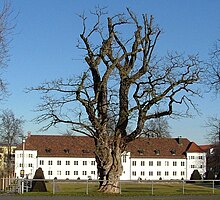Hofgarten (Kempten)
The Hofgarten in Kempten (Allgäu) is a palace garden north of the Prince's Residence of Baroque origin. The park consists of terraces of different heights, which in turn have different sizes. The courtyard garden is a total of 3.4 hectares .
History and description
From 1651, with the new construction of the princely residence and the associated complex complexes, the area north of it also changed: In front of the entrance portal to the residence, a baroque garden was created.
Several fish ponds were created below the slope. The three oval had duck houses in the center, the two each round a fountain. This lower slope was initially also used for growing fruit and vegetables. An open staircase led to the upper slope, the front side of the residence. This baroque ornamental garden was planted with flower beds and symmetrically cut hedges.
The expansion of the park took place in the time of Prince Abbot Honorius Roth von Schreckenstein , who ruled between 1760 and 1785. He had the orangery built in the north end of the court garden . Sensitive plants that are used to warm weather conditions could overwinter in this area.
With the secularization in 1802/3, the Electorate of Bavaria became the owner of the site. The military moved into the residence in the long term, and a parade ground with barracks and riding arenas was set up in the upper courtyard garden . The lower area by the orangery was still used as a vegetable garden, but was built on with warehouses and sheds.
With the establishment of the Prince Franz barracks and artillery barracks , the army slowly moved from the residence to the new domicile of the military. The outdoor facilities and the residence lost their importance and fell into disrepair. In the fall of 1955, after long discussions with the Free State of Bavaria, an agreement was reached with the city administration for a redesign of the upper part.
It was not until 1957 that the Free State leased the site to the city of Kempten. From a city planning perspective, the Hofgarten should belong to the green zone of the city center. The planned park was still covered with a thick layer of gravel from military times and overgrown undergrowth. The Schlangenbach, an artificially created canal system for the early long-distance water supply of the city , flowed through this undergrowth through the Hofgarten.
A year later, the site was leveled in order to be able to build exhibition halls for the Allgäu Festival Week . After the presentation of numerous proposals and drafts, work was started and beds and a well system were designed below the slope. Older trees from Hildegardplatz were transplanted there to restore the character of a park. In 1962, work on the upper and lower courtyard gardens was finished. After a renovation, the city library moved into the orangery.
The former location of the fish ponds was given a rectangular fountain system with fountains. This complex is flanked by two wide stairs. A rectangular mosaic water basin was created in the middle of the upper part of the park. Franz Weiß designed a series of pictures here, which contrasts the important buildings of the imperial city with the collegiate city. The Kommerzienrat Schnitzer donated this pool in 1963. The city councilor and master stonemason Josefa, called Pepi, Röhrle contributed a stone bench above the eastern staircase. The bank bears a chiseled saying in the Allgäu dialect written by Röhrle : "I bi a Stoi vom Grinta , I see 'd'Leit only in front of you, Ma , Wibr , Föhle , Bube , if you are digging with me." (I am a stone from the green, I only see people from behind, men, women, girls, boys when they are resting with me.) Below the slope are table-like objects made of red stone. The right one was donated by Dr. Rudolf Zorn , Bavarian finance minister and patron of the city of Kempten, the left object from his wife Dr. Renate Zorn, whose estate also found its way into the Rudolf Zorn Foundation.
flora
The oldest tree is a black locust from the times of the princely. The tree with a strikingly shaped trunk stands above the slope edge on the western staircase. The black locust can be seen in a painting of the lower courtyard garden with the orangery. The painting was from the beginning of the 19th century. The tree was probably planted around the middle of the 18th century.
literature
- Birgit Kata, City Archives Kempten (ed.): The court garden in Kempten. Kempten, June 2010, 2 pages.
- Dr. Bernd Ziolkowsky: Life in the Hofgarten - The family story of Maria and Robert von Reichert in the Orangery and the Hofgarten at Kempten. 1997.
Web links
- City of Kempten - Hofgarten (accessed March 1, 2013)
Coordinates: 47 ° 43 ′ 46 " N , 10 ° 18 ′ 47.9" E




